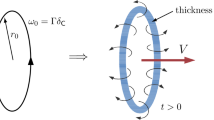Abstract
A computational method is described for evaluating the Biot–Savart integral. The approach emphasizes the transformation of the involved integrand into suitable forms, from which integral theorems can be used to reduce the volume integral into line integrals. This method is applied to the case where the density of vorticity (current) distributed over a volumetric element bounded by planar surfaces (straight lines in two-dimensional) is constant and/or linear. The resulting expressions for the volume integral involve closed-form expressions for line integrals along the edges of the element. The evaluation of the line integrals is treated independently for each of the edges as opposed to direct numerical integration. The closed-form formulas are expressed in terms of geometric parameters of the element edges. The versatility of the proposed scheme is demonstrated by applying it to two examples: (i) two-dimensional lid-driven cavity flows; (ii) a magnetic field induced by a toroidal tokamak coil. A systematic extension to the general cases where the vorticity distribution is of higher-order polynomial form is also presented.
Similar content being viewed by others
References
J. L. Hess and A. M. O. Smith, Calculation of non-lifting potential flow about arbitrary three-dimensional bodies. J. Ship Res. 8 (1964) 22-44.
J. L. Hess and A. M. O. Smith, Calculation of potential flow about arbitrary bodies. Progr. Aeronaut. Sci. Series 8 (1966) 1-138.
B. Bodner, H. Köfler and J. Sammer, 3-dimensional magnetic field calculation for an arrangement of s.c. coils with an outer magnetic core. IEEE Trans. Magn. 28 (1992) 1402-1405.
G. K. Batchelor, An Introduction to Fluid Dynamics. Cambridge: CUP (1967) 615pp.
P. G. Saffman, Vortex Dynamics. Cambridge: CUP (1992) 311pp.
P. M. Gresho, Incompressible fluid dynamics: some fundamental formulation issues. Annu. Rev. Fluid Mech. 23 (1991) 413-453.
L. M. Urankar, Vector potential and magnetic field of current-carrying finite arc segment in analytical form-Part I: Filament approximation. IEEE Trans. Magn. 16 (1980) 1283-1288.
J. E. Kerwin and C.-S. Lee, Prediction of steady and unsteady marine propeller performance by numerical lifting-surface theory. SNAME Trans. 86 (1978) 218-253.
L. M. Urankar, Vector potential and magnetic field of current-carrying finite arc segment in analytical form-Part II: Thin sheet approximation. IEEE Trans. Magn. 18 (1982) 911-917.
Z. M. Cielak and R. B. Kinney, Analysis of unsteady viscous flow past an airfoil-Part II: Numerical formulation and results. AIAA J. 16 (1978) 105-110.
J.-C. Suh, Unsteady Analysis for a Two-dimensional Foil in Uniformly Sheared Onset Flow. Ph.D. thesis., Univ. of Michigan (1990) 140pp.
I. N. Kirshner, The Bilinear Triangular Vorticity Patch. Univ. of Michigan, Informal notes (unpublished) (1989) 32pp.
R. D. Graglia, On the numerical integration of the linear shape functions times the 3-D Green's function or its gradient on a plane triangle. IEEE Trans. Antennas Propagat. 41 (1983) 1448-1455.
D. R. Wilton, S. M. Rao, A. W. Glisson, D. H. Schaubert, O. M. Al-Bundak and C. M. Butler, Potential integrals of uniform and linear source distributions on polygonal and polyhedral domains. IEEE Trans. Antennas Propagat. AP-32 (1984) 276-281.
L. M. Urankar, Vector potential and magnetic field of current-carrying finite arc segment in analytical form-Part III: Exact computation for rectangular cross section. IEEE Trans. Magn. 18 (1982) 1860-1867.
S. Babic and M. M. Gavrilovic, New expression for calculating magnetic fields due to current-carrying solid conductors. IEEE Trans. Magn. 33 (1997) 4134-4136.
C. F. Weggel and D. P. Schwartz, New analytic formulas for calculating magnetic fields. IEEE Trans. Magn. 24 (1988) 1544-1547.
L. Morino, Helmholtz and Poincaré potential-vorticity decompositions for the analysis of unsteady compressible viscous flows. In: P. K. Banerjee and L. Morino (eds), Boundary Element Methods in Nonlinear Fluid Dynamics. Developments in Boundary Element Methods-6. Elsevier Applied Science (1990) pp. 1-54.
I. R. Ciric, New models for current distributions and scalar potential formulations of magnetic filed problems. J. Appl. Phys. 61 (1987) 2709-2717.
I. R. Ciric, Simple analytic expressions for the magnetic field of current coils. IEEE Trans. Magn. 27 (1991) 669-673.
I. S. Gradshteyn and I. M. Ryzhik, Table of Integrals, Series and Products. New York and London: Academic Press Inc. (1965) 1086pp.
K. J. Bai and R. W. Yeung, Numerical solutions to free-surface flow problems. Proc. 10th Symp. Naval Hydro. (1974) 609-647.
W. C. Webster, The flow about arbitrary, three-dimensional smooth bodies. J. Ship Res. 19 (1975) 206-218.
J. N. Newman, Distributions of sources and normal dipoles over a quadrilateral panel. J. Eng. Math. 20 (1986) 113-126.
J.-C. Suh, J.-T. Lee and S.-B. Suh, A bilinear source and doublet distribution over a planar panel and its application to surface panel methods. Proc. 19th Symp. Naval Hydro. (1992) 837-847.
J. P. Guiraud, Potential of velocities generated by a localized vortex distribution. Aerospace Res. ESA-TT-560 (1978) 105-107.
J.-C. Suh, Analytical evaluation of the surface integral in the singularity methods. Trans. Soc. Naval Arch. Korea 29 (1992) 1-17.
T. M. Shih, C. H. Tan and B. C. Hwang, Effects of grid staggering on numerical schemes. Int. J. Numer. Meth. Fluids. 9 (1989) 193-212.
S. Rida, F. Mckenty, F. L. Meng and M. Reggio, A staggered control volume scheme for unstructured triangular grids. Int. J. Numer. Meth. Fluids. 25 (1997) 697-717.
J.-C. Suh and K.-S. Kim, A vorticity-velocity formulation for solving the two-dimensional Navier-Stokes equations. Fluid Dyn. Res. 25 (1999) 195-216.
Author information
Authors and Affiliations
Rights and permissions
About this article
Cite this article
Suh, JC. The evaluation of the Biot–Savart integral. Journal of Engineering Mathematics 37, 375–395 (2000). https://doi.org/10.1023/A:1004666000020
Issue Date:
DOI: https://doi.org/10.1023/A:1004666000020




